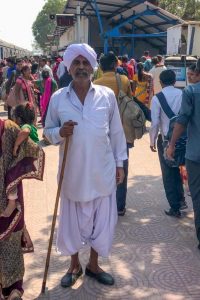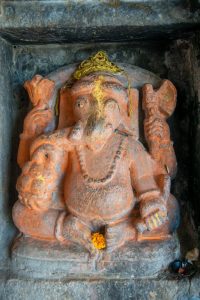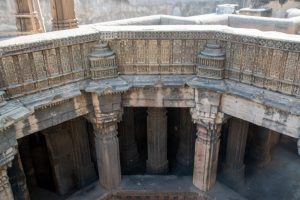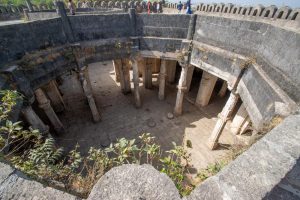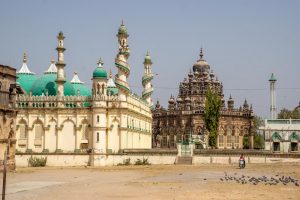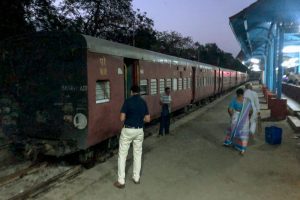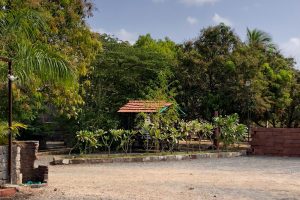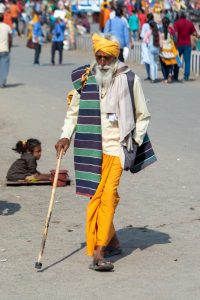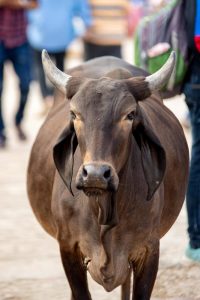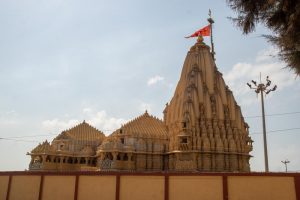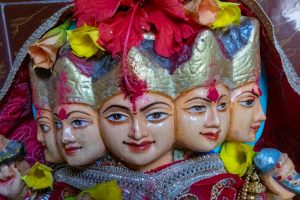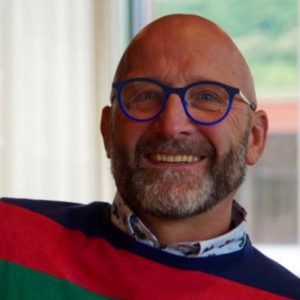The next day I had a slow start as my third class, unreserved seat on a train to Patan would not leave until 10:50 AM. As I would return to the French Haveli in two nights time I decided to leave my main luggage and laundry behind so I could travel light.
A short auto-rickshaw ride brought me to the railway station, or should I say “a” railway station. After a lot of confusion and a couple visits to ticket counters onwards I realised I was at the wrong station. Two friendly policemen helped me into another rickshaw, this time to Sabarmati railway station, a race against time. It was a 6 km ride and I only had 25 minutes till departure. My adrenaline was rushing and I was doubting whether I would make it in time or not. The ride took far too long for my liking but 10 minutes before departing I arrived. At this station however English was hardly unheard of and Confucius ruled. After being sent away at a ticket counter I was sent back there and got my 25 Rs. Ticket (0,30 Euro) for the hundred km journey…. Five minutes to go till platform 4. I only had to find the bridge leading up to the different platforms but was pointed out there by the staff member who rightfully so had refused me entry earlier without a ticket… Four minutes… I hardly had any air in my lungs left by the time I arrived at platform 4. One minute… a quick check whether it was the right train after which I boarded and found a seat. By the time I sat down the whistle blew and my 2 1/2 hour journey had begun…
The only appropriate thing to do was to put my headset and listen to an album of The Yatin Srivastava Project, an Indian Band I absolutely love. It did not take long as soon half the cabin was all over me and we were having an interesting conversation with the help of google translate. After each exchange of question and answer half the cabin was discussing the answer, it was hilarious.
I was asked to show the pictures on my iPhone but decided to show the India pictures on my iPad instead. This made the crowd around me even more dense.
Needless to say time flew by and to early for my liking we arrived in Patan where I took an auto-rickshaw to my hotel. It was nothing special but would do for the next two nights. One of the main reasons to visit Patan was the Rani Ki Kav step well and as it was only a couple of Kilometres away I decided to use the remainder of the afternoon to go there.
It didn’t seem much from afar but once I stood in front of it I realised how astoundingly beautiful the step-well was. Built in 1063 by Rani Udayamati to commemorate her husband, Bhimdev I, the step-well is the oldest and finest in Gujarat and is remarkably preserved. Steps lead down through multiple levels, with lines of carved pillars and more than 800 sculptures, mostly on Vishnu-avatar themes, as well as striking geometric patterns.
Slowly I descended down the steps and admired the magnificent carvings. It is hard to believe that this stunning monument had been lost for centuries, only to be rediscovered and excavated in 1960. It is known as the queen of step wells and without doubt it is the most breathtaking one I have visited in India so far.
Just a couple of hundred meter further on was the Sahastralinga tank, a medieval artificial water tank which now is empty and in ruins. Still looking rather nice but after the magnificent Step-well rather unimpressive, the most interesting were the monkeys on the premises enjoying themselves.
A short ride later I was dropped at the Panchasara Parshvanath Jain Temple. A beautiful and serene temple with hundreds of Jain Buddha statues and a small prayer hall.
It was here I was greeted by two guys, a Westerner and an Indian I had seen before at the step-well Panchasara Parshvanath Jain Temple and so we started to chat.. It turned out that Chirag, the Indian guy was hosting Andrea, the Italian, for a couple of days. I was invited to come home with them for a cup of coffee and I gladly accepted. Chirag made a short phone-call and not much later a friend of him came on a motorcycle to pick me up. Once at Chirag’s place we enjoyed a nice cup of coffee and got engaged in a wonderful conversation. Andrea had great travel stories to tell and I was really interested in an app couchsurfing he used to get in touch with locals and stay with them. A perfect way to discover places from the inside. But as Andrea had a 8 o’clock bus to catch I left around seven, giving him some time to take care of things. Once again a friend was chartered with a motorbike who brought me to the main road where I said goodbye to Chirag and Andrea. It had been an unusual and extremely pleasant encounter.
I found a decent restaurant in the area and enjoyed a Gujurati thali after which I returned to my hotel. Another day had come to an end and what a wonderful day it had been…
Next morning there was no electricity, apparently a technical problem which could last 4-5 hours… no electricity means no hot water, no breakfast, no WiFi to send Vladi a good-morning message…
The world came to a stand still. Fortunately I was still able to organise a taxi to the Modhera Sun Temple, the second reason why I had travelled to Patan.
Modhera is about 30km south of Patan and the trip took us just under an hour, at times I felt I was witnessing someone‘s first driving lessons but we made it in one piece at the end.
After I paid my entrance (12 times the entrance fee of a local) I was allowed to enter the park and I could already see the temple from the distance.
Built in 1027 by Bhimdev I, this is one of the greatest monuments of the Solanki dynasty, whose rulers were believed to be descended from the sun. Like the better-known Sun Temple at Konark in Odisha, which it pre- dates by 200 years, the Modhera temple was designed so that the dawn sun shone on the image of Surya, the sun god, during the equinox.
In front of the temple I saw Surya Kund, an extraordinary rectangular step-well, which contains more than 100 shrines, resembling a sunken art gallery.
Having seen both the step-well and the sun temple definitely was worth the journey to Patan. Still deeply impressed the 30km return journey to Patan started. My driver was chewing some kind of tobacco so it was nice and quiet and I could thoroughly “enjoy” the music blasting out of the speakers.
Once back at the hotel electricity had not been restored yet so I went “downtown” for a stroll through the area and a bit to eat. As it was Sunday all shops were closed and the place was rather dull. Therefor I returned to the hotel for an afternoon nap. By the time I woke up the electricity was back, and so was the internet, finally I could call Vladi.I decided to pay my bill so in case I would wake up early I could catch the 6:00 AM train in Patan as there was not much further to explore.
That evening I tried to watch “The Joker” on my iPad but the internet connection was not good enough for that so instead I went for an early night.
I had set the alarm at 4:45 in order to catch the 6AM train but by the time it went of I thought it wasn’t such a good idea after all so I stopped it and continued to sleep… later, at 8.15 I woke up again, a much more civilised time, and time enough to catch the next train.
As the hotel’s restaurant was not that appealing I checked out and took an auto-rickshaw to the railway-station where, after some obvious confusion, I got my ticket to Sabimati, the railway-station in Ahmedabad where I also left two days ago. listening to music was no option as everybody in the couch was interested to talk to me, but that way the 2 1/2 hour journey went by quickly.
After I had dropped my stuff at the French Haveli I looked up a barber to have my beard trimmed. That procedure included a head, neck and shoulder massage and set me short just under 2 euro’s, a bargain.
Andrea, the Italian I had met in Patan had recommended the Bai Hari Vav stepwell, and with some hours to spend I decided to give it a go.
The step-well and mosque were built by Hazrat Bai Harir Sultani, a very religious, influential woman. She was the superintendent of the royal harem at Abul Fatah Nasredin Mahmud Shah. She had established this incredible heritage not from the royal treasury but from the capital deposited from her salary, it was costed three hundred twenty eight thousand silver coins 520 years ago.
On arrival it did not look like much but I already know that at step-wells the real beauty is to be discovered underground. And so it was. Perhaps not as much carvings as the one in Patan but the beautiful of this one is that I almost had it to myself and some resident monkeys. Behind the step-well was a small mosque and the friendly keeper gave me a piece of cloth so I could cover my legs and enjoy the place.
My final stop in Ahmedabad was Sarkhej Roza, a mosque and tomb complex located in the village of Makarba, 7 km south-west of Ahmedabad,
Although there are many Roza’s across Gujarat, the Sarkhej Roza is the most revered. Sarkhej was once a prominent centre of Sufi culture in the country, where influential Sufi saint Shaikh Ahmed Ganj Baksh lived. It was on the saint’s suggestion that Sultan Ahmed set up his capital on the banks of the Sabarmati, a few miles away from Sarkhej.
Immediately on arrival I realised it had been a good decision to visit this impressive complex. It also turned out to be one of the most open and friendly mosques I had visited so far.
Of course I could not leave Ahmedabad without one final visit to Manik Chowk, the food market where I thoroughly enjoyed my special dosa and some fruit shots. A worthy finish of my stay in Ahmedabad.
It was time to leave the north of Gujarat and travel further south, so next morning I took the train for a 6 1/2 hour ride to Junagadh. As I had booked sleeper class it was a quiet and relaxing journey and I arrived by 15:30 when I took an auto-rickshaw to my hotel. I decided not to do anything anymore and relax for the remainder of the day.
Next day I had a couple of sites on my wish list. After breakfast I packed my camera and got in an auto-rickshaw for the first stop, Uperkot fort located on a hill above Junagadh. This ancient fort is believed to have been built in 319 BC by the Mauryan emperor Chandragupta, though it has been extended many times. In places the ramparts reach 20m high. It’s been besieged 16 times, and legend has it that it once withstood a 12- year onslaught. The views over the city and east to Girnar Hill was superb, and within the fort’s walls is a magnificent former mosque, a set of millennia-old Buddhist caves and two fine step-wells.
The mosque had seen better days but was a beloved place for wedding photography. I still don’t understand why there was a 300INR entrance fee to the caves as there was literally nothing to be seen, quite a disappointment. The wells, the oldest ones I had seen so far were more interesting, they were lacking the fine carvings of the previous ones I had visited but were much much older.
Another rickshaw ride further brought me to the stunning mausoleum of Nawab Mahabat Khan II of Junagadh (1851–82) , which seems to bubble up into the sky. It’s one of Gujarat’s most glorious examples of Euro- Indo-Islamic architecture, with French window’s and Gothic columns, its lavish appeal is topped off by its silver inner doors. Very special indeed were the minarets with spiral staircase around them, something I had not seen before. As I saw locals in the top of the minaret I could not resist to climb them myself in order to get a different view from the mausoleum.
As I was in the centre of the city I strolled around and breathed the atmosphere. Like everywhere in India a stroll through the city centre is a wealth of new impressions and experiences. The constant buzz, the chaotic traffic, food stalls and friendly people everywhere. I simply loved it.
The temperature was rising quickly so I decided to return to my hotel to escape the worst heat. I relaxed and read a bit in my book before I decided to visit one final place on my list, the Shri Swaminarayan Mandi Temple. It is a Hindu temple of the Swaminarayan Sampraday sect and one of the temples that were built directly on the instructions of Swaminarayan himself. Stylistically it is similar to other Swaminarayan temples, but much more colourful and without the Hindu nationalistic historiography.
I was greeted here by countless devotees who al wanted to know where I was coming from. A priest gave me the grand tour (in Hindi so I did not understand a word) and made sure I made enough pictures. In the end he brought me to the sect leader for a friendly conversation (in English this time) and a cup up tea. What an experience and what a way to finish of my day in Junagadh.
An early rise was scheduled for the next day and this time i had no choice as the 7:15 train was the only daily departure to Sasha Gir, my next stop. It was still dark when I left the hotel but with a bit of luck I was able to find an auto-rickshaw that brought me to the railway-station. There I bought a 0,26 Euro ticket for the two and a half hour train-ride to Sasan Gir. The train was already at the platform, but as I was early they were just unlocking it. After making sure it was the right train I was invited to take place in a dark wagon. With it’s wooden benches it was the least comfortable train I ever had in India but then what can you expect on a local train for 20 INR… For that price I simply had to endure the bare wooden benches, but then to be honest, I was enjoying it. Soon the sun started to set and I could see a little bit more, the train departed punctually and I was ready for my new adventure.
The first part of the journey I was accompanied by people who did not speak English, a good opportunity to listen to some music and enjoy the scenery passing by. In one of the stations my fellow passengers got out but it did not take long before the seats were taken again. The man now sitting next to me greeted me and not much later we were engaged in a friendly conversation. By now we were crossing the national park, a forested area, and this is where I saw the first wildlife, peacocks, deer and some other animals which I did not know the name of.
On arrival in Sasan Gear I was a bit puzzled as it really appeared to be in the middle of nowhere, with no auto-rickshaws available. But not for long… not much later one arrived and I was on my way to Lions Paw Resort which was even further away from everything … it looked nice, the pool was filled and the sun was shining, about all the excitement around.
I enquired about the lion safari’s only to find out they were a staggering 95 Euro for a one hour drive. It was completely out of proportion and outrageous so I decided to skip it on the spot. I had already expected this so the disappointment wasn’t too bad. After over two weeks in India it would be great to have a break, enjoy the sun, the pool and a book. Time to relax.
And so I did, After all the buzz, noise and chaos I had experienced so far it was rather strange to hear the sound of silence and birds singing. I was the only guest in the resort and in spite of about ten staff members or so being present. nothing seemed to be going on. Internet connection broke a couple of hours after my arrival and I felt more distant from Vladi than ever. It was the first time we could not be in touch and although we had expected this to happen sooner or later I had not realised the impact would be that big. For the first time on this trip I felt lonely.
But then I should not be complaining, I had a large “private” pool, the sun was shining and I was making good progress with “Shantaram”, a book I had started a year ago and had not find the peace to finish. So I changed my mindset and tried to enjoy almost three extremely quiet and relaxing days before continuing my adventure. Still I slept restless that night as I could not be in touch with Vladi.
At the end of the second day a big surprise awaited me, while I was finishing of “Shantaram” one of the staff members knocked on my door and brought a telephone, a friend for you Sir… puzzled I took the phone only to be welcomed by a voice I knew very well… Not having heard from me for a day and a half Vladi had looked up the phone number of the hotel just to hear my voice and make sure I was well. It was such a (pleasant) shock I broke out in tears. Immediately both of us felt calm knowing we were doing well, I was worried how Vladi was feeling now we could not be in touch and he was worried about my wellbeing. Things were fine now and both of us could relax. Not much later the internet connection was reestablished and in spite of our previous phone-call we had a long Video-chat, it was so good to see my love, and WhatsApped the remainder of the evening…
Unexpectedly and thanks to knowing Vladi was as near as my phone the next day went by rather quickly and it was time to get back to the “civilised world”. I arranged an auto-rickshaw to the railway-station where I bought my 10 INR (0,13 Euro!) ticket to Somnath, an hour and a half drive.
The train ride was magical as usual with deers and monkeys coming coming as close to the tracks as they dearer to. There were intereSting and colourful people waiting on the platform for the train which arrived punctual. Pretty soon after we departed we left the national park and were now surrounded by agricultural areas. I loved the journey.
The arrival in a busy city was a bit of a shock after almost three extremely peaceful and quiet days, but this was India, a land of extremes. I took an auto-rickshaw to my hotel and not much later we passed the busy port of Veraval. Thousands of boats were anchored next to each other and I wondered how they ever would be able to sail out. One thing I knew for sure I would return here to make some pictures as it was an absolute fabulous sight.
My hotel turned out to be in a cluster of hotels, just on the outskirts of Somnath and near to the railway-station. On check in my temperature was measured and I was given hand sanitiser a counter measurement for the corona virus. My room was superb and as I hadn’t had a warm shower for 3 days I thoroughly enjoyed this one. After lunch I checked my opportunities and i decided to book a day trip to Diu, just to make things a bit more easy going than using public transport (2 1/2 hour one way).
I relaxed a bit and then decided to go to the Temple of Somnath for the evening prayers. It’s said that Somraj (the moon god) first built a temple in Somnath, made of gold; this was rebuilt by Ravana in silver, by Krishna in wood and by Bhimdev in stone. The current serene, symmetrical structure was built to traditional designs on the original coastal site; it’s painted a creamy colour and has a little fine sculpture. The large, black Shiva lingam at its heart is one of the 12 most sacred Shiva shrines, known as jyoti linga.
Security was heavy but this time I was informed ahead to leave everything behind (including my Apple Watch) so I only had some loose cash with me as I was wearing my jeans for the first time whilst in India. I was checked twice and as a foreigner had to fill in a guestbook before I was allowed to enter the premises of the temple. It looked amazing with it’s creamy colour contrasting with the crystal blue sky.
There was a serene atmosphere, pilgrims were praying and chanting and queuing up in order to see the Shiva Lingam. I decided to join the queue and coming close to the inner sanctum I noticed all stones and pillars were now covered with gold. The queue behind me was large and guards took care nobody stayed too long at the Shiva lingam so I moved on after I admired it.
The temple was built on the shoreline and as the sun was setting I took a seat on one of the plentiful benches and admired the wonderful glow in which the temple looked even more beautiful than before. At 7PM the puja started and people were now desperately trying to get close to the Shiva linesman and participate in the chanting and clapping. I simply loved the serene atmosphere.
At 8PM a Sound and Light-show was scheduled but I decided to leave it as it was, perhaps another evening. I made my way back to the exit and returned to my hotel for dinner and a quiet evening.
The next day I had booked a trip to Diu, about 90 Kilometre from Somnath. It took just over two hours to get there over a road that was heavily under construction at places and rather crowdy.
My first visit was to the cavernous St Paul’s church, founded by Jesuits in 1600 and then rebuilt in 1807. Its neo-classical facade is the most elaborate of any Portuguese era church in India. Some people were praying in the church which from the inside was rather bare with little decorations. I wondered how it looked like in 1807…
A short walk further was the St Thomas’ Church, a lovely, simple building with walls decaying in genteel fashion. It now houses the Diu Museum, with a spooky, evocative collection of wooden saints going back to the 16th century and particularly creepy armless angels.
In front of it was a large fountain which at the time I was there unfortunately was not functioning. the houses in the area looked more Portuguese than Indian and were very colourful.
Then my driver brought me to the fort. Built in 1535, with additions made in 1541, this massive, Portuguese fort with its double moat (one tidal) was one of the most important Portuguese forts in Asia. Today sea erosion and neglect are leading to a slow collapse. Cannonballs litter the place, and the ramparts had a superb array of cannons. The lighthouse is Diu’s highest point, with a beam that reaches 32km. There were also a couple of small chapels, shining in their neglect.
There were quite a lot of local tourists around, all more involved in taking selfies at the perfect spot, than trying to get something to know about the fort’s history. I was already used to it but this day the number of pictures from me with unknown Indians have massively increased. Oh well, as I am taking pictures of locals at least I could do is have them enjoy making pictures from me. “Where are you from?”
Although a local guide was promised no one was available, but Ali, my driver tried to do his best but his knowledge was limited. Glad he was a slightly better driver than guide.
As it was lunchtime I asked to go to a restaurant. As Diu is the only place in an otherwise dry state where you can have a drink I was delighted to enjoy a Kingfisher beer by my Tandoori chicken, followed by an Old monk rum as desert. It was my first drink in three weeks time and I really felt I had deserved it.
After lunch we headed towards the Gangeswar temple. It is believed to have been built by the Pandavas who stayed here for quite some time when they were exiled. The sanctum here has five shivalingas, one built by each Pandava. The temple sits on the rocks right by the raging sea and you might have short waves coming right inside the temple. It was a nice visit and I enjoyed the activity around this modes place.
Next we went to a beach which could not thrill me at all, I guess I am spoiled after all these years. Another beach left me equally unimpressed and with the idea that the other beaches would be equally boring I proposed to start the journey home. It had been an interesting day.
Back at the hotel I had an argument with the tour operator as he had charged me 700INR for a local guide who didn’t show up, nor would have had much added value. I asked for a refund which obviously I did not receive and instead of continuing the argument (which I would loose anyway) I told him to look forward to a “wonderful” review on Tripadvisor.
My last day of sightseeing in Somnath had arrived and I had a couple of things on my wish-list. First I returned to the Temple of Somnath in order to make some pictures from outside the fence. When I strolled around Somnath’s most famous and worshipped temple I once again realised it are not the temples, monuments and archeological wonders that make India. It are it’s people, colourful, vibrant, overly friendly and each of them finding their own way to survive in this overpopulated country. The amazing smiles make my heart melt each and every time. It’s an amazing spectacle and one only needs to open their eyes to see this splendour unfold. It’s magic, pure magic! Needless to say my photographers hart started beating faster as I shot on amazing portrait after the other and I was enjoying myself tremendously.
Not far from the entrance to the Somnath Temple lies the Mahakali Kaa temple, a rather small and often overlooked temple. My curiosity drove me towards it and after I left my shoes an amazing experience waited for me. I was allowed to descend into the inner sanctum of the temple where I saw people worshipping and was invited to join them. It was a surreal but serene to be part of this ongoing puja and before I left the temple the Shiva mark was put on my forehead, as proof I had visited the temple.
On arrival at Veraval railway-station I had already noticed the harbour was something really special so I took another auto-rickshaw for the 7 km drive. The harbour of Veraval is the home of an amazing collection of fishing boats and I was absolutely puzzled how they ever were able heading to the see as there seems no end to the endless amounts of colourful boats that were moored next to each other. Unfortunately I was too late to see the fish market but it was a short side-trip definitely worthwhile…
On arrival at the harbour I was greeted by a group of guys who wished me a happy Holi and sprayed me with bright pink paint to mark the event. I asked them to respect my camera which they gladly did.
It was getting close to lunch time so I returned to my hotel to get rid of the paint on my body (suddenly I got the fear it would be paint of a more permanent sort) and enjoy a small lunch. I was happy to get the paint of my arm and decided to wear my sprayed clothes for the remainder of the day, just in case…
After lunch I decided for a long walk as I had noticed there were some more temples to be seen on the outskirts of Somnath. My first stop were Buddhist caves which were sadly neglected and in spite of a large billboard pointing them out were not interesting at all.
At the next place, the Gupteshhwer Mahadev I had more luck, it was a small colourful temple and next to it I could descend into a shrine under the earth where there also was access to a small underneath well.
I walked over a giant ring road through an area that was almost completely unused, weird, but then the ring road might be specially constructed for the use during festivals when masses of people are attracted to the Somnath temple.
The next place that caught my eye was the Harihar Van, a rather new place of worship which was added to the already countless number of temples and shrines in the area.
It was obvious that the road I was following one way or another had to lead to the Somnath temple and soon I was on common ground. There I spend some more time to enjoy the colourful people and after I found a working ATM to stock up on some cash I continued my walk back to the hotel. It was so warm however that I decided to take an auto-rickshaw instead for the final two kilometres. Back at the hotel it was time for an afternoon nap, i had thoroughly enjoyed my final day in Somnath but was getting rather tired once again.
The next day was a travelling day, time to return to Ahmedabad, a 9 hour journey. Glad I had booked sleeper class so it would be another relaxing journey. My time in Gujarat was over and when I look back at the last three weeks I can only say they have been marvellous. It started with a day in Mumbai before I took the took the train to Vadodara, my first place to visit in Gujarat. I had seen countless sites, enjoyed the chaos and buzz that is so typical for Indian cities. The food had been simply amazing and everywhere I was greeted by countless smiles and questions “where are you from?”. This time I have gone under in Indian life much further than I ever thought I would dare. I travelled on local busses, 3rd class unreserved couch trains, and I cherish these experiences as some of the best I had the last couple of weeks.
The only thing that was remaining was a short night in an airport hotel before taking two flights to my next destination. Part two of my India 2020 trip is about to begin, but that is another story…
Finish the journey in Odisha






